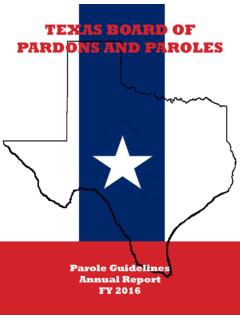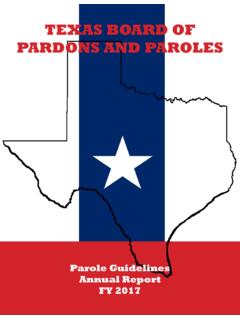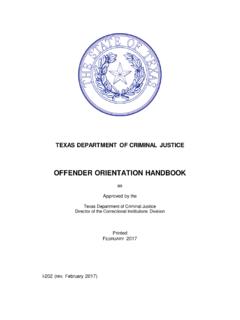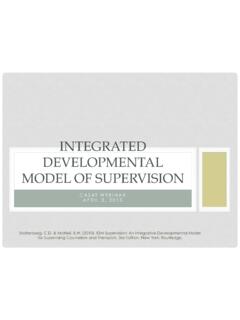Transcription of Battering Intervention and Prevention Program (BIPP ...
1 Effective April 2014 Texas Department of Criminal Justice Community Justice Assistance Division Battering Intervention and Prevention Program (BIPP) Accreditation Guidelines 2 Table of Contents Section I: Introduction Mission Statements Texas Department of Criminal Justice 4 Community Justice Assistance Division 4 Battering Intervention and Prevention programs 4 Section II: Preface History and Development 5 Battering Intervention and Prevention Program Accreditation 5 Purpose 5 Section III: Guidelines Program Operations 6 Background Check 6 Initial Training Requirements 6 Staff Development 7 Staff Supervision 8 Case Records 9 Confidentiality 10 Confidentiality Pertaining to Community Education and Media Contact 11 Fee and Payment Scales and Procedures 11 Program Duration 11 Program Format 12 Program Curriculum 13 Assessment Procedures 14 Exits 15 Written Participant Agreements 17 Victim Contact and Notification 18 Reporting Requirements 19 Community Education and Referral System 20 Community Education 20 Referral System 21 Section IV.
2 Best Practices Program Assessment and Evaluation 22 Research 22 Coordination of Activities 22 Community Education/Advocacy 24 3 Section V: Appendices Appendix A: Supplemental Information and Forms 26 Appendix B: Glossary 38 Appendix C: Texas Code of Criminal Procedure, Article 43 Appendix D: Texas Code of Criminal Procedure, Article , Section 14 48 Appendix E: Texas Family Code, Subtitle E, Chapter 261, Sections and 49 Appendix F: Texas Human Resources Code, Title 2, Chapter 48, Sections and 51 Appendix G: Recommendations and Resources for Specialized Populations 53 4 Words that are in bold and italicized have been defined and can be found in Appendix B: Glossary. Mission Statements Texas Department of Criminal Justice The mission of the Texas Department of Criminal Justice is to provide public safety, promote positive change in offender behavior, reintegrate offenders into society, and assist victims of crime.
3 Community Justice Assistance Division The mission of the Community Justice Assistance Division is to be accountable, responsive, and effective stewards of funding and other resources by assisting our collaborative partners to promote safer communities through rehabilitative services for offenders and protections of victims rights. Battering Intervention and Prevention programs The mission of Battering Intervention and Prevention programs in Texas is to eliminate male to female intimate partner violence by providing services to batterers, promoting safety for victims, and bringing about social change necessary to end Battering and all other forms of abuse. Section I: Introduction 5 History and Development The Battering Intervention and Prevention Program (BIPP) Guidelines were developed for the Texas Department of Criminal Justice-Community Justice Assistance Division (TDCJ-CJAD) by the BIPP Strategic Planning work Group of the Texas Council on Family Violence (TCFV) in 1993-1994.
4 These guidelines became effective September 1, 1995. In early 1998, TCFV and TDCJ-CJAD formed a committee to examine the BIPP Guidelines and propose revisions, additions, and deletions. This revision of the BIPP Guidelines became effective as of December 1, 1999. Battering Intervention and Prevention Program Accreditation During the 80th Texas Legislative Session, Senate Bill 44 was passed (Texas Code of Criminal Procedure, Article ). This Code relates to the provision of Intervention or counseling services for persons who have committed family violence and to a process for accrediting those services. In late 2007, TDCJ-CJAD formed a committee to examine the BIPP Guidelines for Program accreditation. The committee was comprised of representatives from TDCJ-CJAD funded and non-funded Battering Intervention and Prevention programs (BIPPs), family violence Program , Community Supervision and Corrections Departments (CSCDs), TDCJ-Parole Division, medical examiners, psychologists, marriage and family therapists, licensed professional counselors, social workers, and other professionals.
5 Following the recommendations of the committee, TDCJ-CJAD and TCFV submitted a draft to the committee members, BIPPs, licensing authorities described by Chapters 152, 501, 502, 503, 505, Occupations Code and other stakeholders for their review and comments. Their recommendations were incorporated into the BIPP Accreditation Guidelines that were effective as of July 2009. In 2013, TDCJ-CJAD, in consultation with TCFV, examined and revised the BIPP Accreditation Guidelines and submitted a draft to all accredited programs , stakeholders, and TDCJ-CJAD auditors. Their recommendations have been incorporated in the 2014 guidelines. Purpose The purpose of the Guidelines is to clarify the Program and administrative standards under which an accredited Program must operate if they are to receive accreditation by TDCJ-CJAD.
6 The Texas Code of Criminal Procedure, Article (See Appendix C), defines the nature and consequences of family violence and establishes the parameters of BIPPs. Because the preponderance of family violence is male to female Battering , it is important for Battering Intervention and Prevention programs to acknowledge the gender-specific nature of that violence. Accredited programs may provide services to other populations ( female and juvenile batterers or anger management groups). However, accreditation issued by TDCJ-CJAD is solely for the purpose of providing direct services to adult males. Section II: Preface 6 Program Operations Background Checks GUIDELINE # 1 Accredited programs shall develop a policy on completing background checks on all persons who will provide direct Battering Intervention services to family violence offenders, including both paid and unpaid positions.
7 Background checks shall be documented and kept in each staff member s personnel or administration file. At a minimum, the policy shall require: 1. Both Texas Crime Information Center (TCIC) and National Crime Information Center (NCIC) fingerprint background checks to be conducted. 2. Background checks to be completed before providing direct services to batterers and to be conducted at a minimum of once every three years from an employee s date of hire. 3. The development of criteria regarding eligibility of staff candidates with criminal backgrounds. 4. The development of procedures regarding addressing criminal background convictions and protective orders for current staff members. See Appendix A for Supplemental Information and Forms Best Practice: Former batterers who want to work directly with batterers should have successfully completed a BIPP Program .
8 Former batterers should have lived violence-free for 3-5 years before providing direct service to batterers. Initial Training Requirements GUIDELINE # 2 Accredited programs shall document initial training for new staff. Staff working directly with batterers and/or supervising staff who work directly with batterers shall document initial training hours according to the following parameters: 1. Documentation of training hours completed must be kept on file and available for TDCJ-CJAD review and approval. A list of CJAD approved training opportunities is available in the appendix. 2. Forty hours (15 hours of family violence and 25 hours of Battering Intervention ) must be completed. CJAD-approved topics are listed in the appendix. 3. Ethics training hours are limited to six hours. 4. Training hours must be completed within six months of the date of employment; and Section III: Guidelines 7 5.
9 Training hours must be completed before working unsupervised with batterers. 6. In-house training will be documented to include staff attendance list, date, time and training topics. Exception: If staff meets the following criteria, they may qualify for a reduced number of initial training hour requirements. Licensed four years and four years working in the field of Battering intervention1 Licensed counselors, social workers, marriage and family therapists, psychologists, and psychiatrists who have been licensed for four or more years and worked in the in the field of Battering Intervention for four or more years working directly with batterers and are in good standing with their licensing boards shall document and submit initial training hours according to the following parameters: 1.
10 Documentation of training hours completed must be kept on file and available for TDCJ-CJAD review and approval. A list of CJAD approved training opportunities is available in the appendix. 2. Fifteen hours (5 hours of family violence and 10 hours of Battering Intervention ) must be completed. CJAD-approved topics are listed in the appendix. 3. Ethics training hours are limited to six hours. 4. Training hours must be completed within six months of the date of employment; and 5. Training hours must be completed before working unsupervised with batterers. 6. In-house training will be documented to include staff attendance list, date, time and training topics. See Appendix A for sample form. BEST PRACTICE: Paid or volunteer administrative support staff should have knowledge of the Program s mission, policies and TDCJ-CJAD BIPP Accreditation Guidelines.













